Fermented Veggies Are Easier to Make Than You Think
Did you know that nearly one-third of Americans are interested in incorporating fermented foods into their diets? Making fermented veggies at home is simpler than you might think. With just a few fresh ingredients and minimal effort, you can create delicious, probiotic-rich snacks that enhance your meals. Curious about how to get started? Let’s explore the basics of fermentation and the easy steps to transform your favorite produce into zesty, gut-friendly treats.
Key Takeaways
- Fermenting veggies at home requires no fancy equipment, just fresh vegetables, salt, and water.
- The process simply involves submerging veggies in a saltwater brine to create tangy flavors.
- You can customize your ferments with various herbs and spices to match your taste preferences.
- Fermentation enhances gut health by introducing beneficial probiotics into your diet.
- With just a few days of patience, you can enjoy delicious, probiotic-rich fermented veggies.
Understanding Fermentation Basics
Have you ever wondered how simple vegetables can transform into tangy, probiotic-rich delights?
Fermentation is the magical process that allows this transformation.
When you embrace fermented vegetables DIY, you harness natural bacteria and yeasts to preserve and enhance flavors.
As you submerge veggies in a saltwater brine, these microorganisms break down sugars, producing lactic acid.
This not only creates that delicious tang but also boosts the nutritional profile.
The result? Crunchy, zesty bites packed with probiotics that can improve gut health.
With just a few steps, you can turn fresh produce into vibrant, flavorful staples for your meals.
Additionally, the fermentation process can be tailored with various spices and herbs to customize flavors according to your preference.
Essential Ingredients for Fermenting Veggies
To successfully ferment veggies, you’ll need a few key ingredients and some handy tools.
Think fresh vegetables, salt, and water as your foundation, while jars or fermentation crocks will be your best friends in this flavorful journey. Adding live cultures like those found in yogurt can enhance the fermentation process and boost the health benefits of your homemade creations.
With these essentials, you’re ready to create vibrant, tangy treats right in your kitchen!
Basic Ingredients Needed
Fermenting veggies transforms ordinary vegetables into tangy, probiotic-rich delights, and getting started requires just a few essential ingredients.
First, you’ll need fresh, crisp vegetables like cabbage, carrots, or cucumbers.
Next, high-quality sea salt is crucial, as it helps draw out moisture and creates the perfect brine.
You can also add spices, herbs, or garlic for extra flavor.
Finally, filtered water is important to ensure a clean fermentation process.
With these simple ingredients, you’re on your way to creating delicious, gut-friendly ferments that’ll add zing to your meals and boost your health in the process!
Tools for Fermentation
When diving into the world of fermentation, having the right tools makes all the difference in achieving that perfect crunch and tang.
Start with high-quality glass jars, which let you monitor your veggies as they transform. A trusty fermentation weight keeps your produce submerged, while an airlock lid prevents unwanted contaminants. You’ll also want a sharp knife and cutting board for prepping your veggies. Measuring spoons and a funnel help with precise ingredient ratios and easy transfers. Don’t forget a kitchen scale for accuracy!
With these essential tools, you’ll be well-equipped to create delicious, tangy fermented veggies at home.
Simple Steps to Get Started
Getting started with fermenting veggies is easier than you might think!
First, you’ll need a few essential ingredients to kick off the fermentation process, which transforms fresh produce into tangy delights. Fermentation not only enhances flavor but also introduces beneficial probiotics for gut health, making your homemade creations a nourishing addition to your diet.
Once you’ve gathered your supplies, you can follow a simple process that brings your veggies to life with flavor and probiotics.
Essential Ingredients Needed
To embark on your fermentation journey, you’ll need a few essential ingredients that make the process both simple and rewarding.
Start with fresh vegetables, like cabbage or carrots, as they hold the natural sugars needed for fermentation.
You’ll also require non-iodized salt, which helps create the brine and promotes beneficial bacteria growth.
For extra flavor, consider adding spices like garlic, ginger, or chili flakes.
Finally, a clean glass jar or fermentation crock is essential for containing your veggies.
With these ingredients on hand, you’re ready to dive into the world of delicious, tangy fermented vegetables!
Fermentation Process Explained
How do you turn fresh vegetables into a flavorful, tangy delight? It’s simple!
Start by chopping your veggies and mixing them with salt to draw out moisture.
Pack the mixture tightly into a clean jar, ensuring it’s submerged in its own brine.
Cover it loosely to allow gases to escape while keeping dust out.
Store your jar in a cool, dark place for a few days to a couple of weeks, depending on your taste preference.
Taste periodically until you reach the perfect tang.
Finally, refrigerate your fermented veggies to slow down the fermentation process and enjoy your homemade creation!
Choosing the Right Vegetables
Which vegetables will elevate your fermentation game?
Start with crunchy carrots, vibrant radishes, or crisp cucumbers; their natural sugars and water content create a perfect environment for fermentation.
Don’t overlook cabbage, especially when making classic sauerkraut—its high fiber content aids in the process.
You can also experiment with beets, green beans, or even garlic for unique flavors.
Choose fresh, organic produce whenever possible, as they’ll yield the best results.
Remember, the fresher the vegetable, the more robust the fermentation. Incorporating these vegetables into your diet can enhance your gut health by introducing beneficial probiotics-rich foods to your system.
Tips for Successful Fermentation
Ever wondered what it takes to achieve perfect fermentation? Start with fresh, organic vegetables—quality matters!
Cut them into uniform pieces for even fermentation.
Use the right salt, preferably non-iodized, to kickstart the process without inhibiting good bacteria.
Don’t forget to pack your veggies tightly in the jar, ensuring they’re submerged in their brine; this prevents spoilage.
Maintain a consistent temperature, ideally between 65°F and 75°F, to encourage healthy fermentation.
Lastly, keep an eye on your mix; taste it periodically to find that perfect tang. Incorporating beneficial probiotics into your diet through these veggies can significantly enhance your gut health.
With these tips, you’ll soon be enjoying delicious, homemade fermented veggies!
Flavoring Your Fermented Veggies
Have you ever considered the endless possibilities for flavoring your fermented veggies?
You can easily elevate their taste to a whole new level!
Here are three fantastic ways to infuse flavor:
-
Herbs and Spices: Add fresh dill, garlic, or chili flakes for an aromatic kick.
-
Citrus Zest: Incorporate lemon or lime zest for a refreshing, zesty twist.
-
Sweet Elements: A touch of honey or maple syrup can balance the tanginess.
Experimenting with these ingredients allows you to create unique blends that excite your palate. Plus, incorporating fermented veggies into your diet can enhance your gut health and overall well-being due to their health benefits. Don’t be afraid to get creative and discover your favorite combinations!
Storing and Enjoying Your Creations
Storing and enjoying your homemade fermented veggies is just as important as the fermentation process itself.
Once they’re ready, transfer them to clean, airtight jars to keep them crisp and flavorful.
Store your creations in the fridge; the cool temperature slows fermentation, preserving that tangy goodness.
Remember, fermented veggies can last for months, so don’t hesitate to enjoy them!
Incorporate them into salads, sandwiches, or as a zesty side dish.
Their vibrant colors and bold flavors will elevate any meal.
Take a moment to savor your hard work—you’ve crafted something delicious and nutritious that’s perfect for sharing! Additionally, these fermented veggies can also serve as a source of gut health benefits, enhancing your overall well-being.





